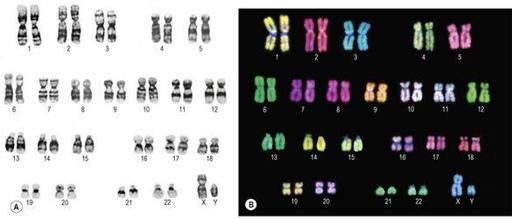Ross & Wilson Anatomy and Physiology in Health and Illness (197 page)
Read Ross & Wilson Anatomy and Physiology in Health and Illness Online
Authors: Anne Waugh,Allison Grant
Tags: #Medical, #Nursing, #General, #Anatomy

Introduction to genetics
Chromosomes, genes and DNA
428
Chromosomes
428
Genes
428
DNA
428
Mutation
429
Protein synthesis
430
Messenger ribonucleic acid (mRNA)
430
Cell division
431
Mitosis
432
Meiosis
432
The genetic basis of inheritance
433
Autosomal inheritance
433
Sex-linked inheritance
434
Genetic basis of disease
435
Cancer
435
Inherited disease
435
ANIMATIONS
17.1
Karyotype
428
17.2
Sex determination
428
17.3
Complemetary base pairing of DNA
429
17.4
Transcription
431
17.5
Translation
431
17.6
Crossing over
432
17.7
Hereditary traits
433
17.8
Punnett square
433
17.9
Sex-linked traits
434
All living organisms, including human beings, need to reproduce, so that at the end of their life span they have produced at least one, probably many, other individuals to replace themselves. This ensures the continuation of their species. Babies inherit from their parents a copy of all information needed to develop into a functioning member of their species; this information is carried as deoxyribonucleic acid (DNA), mainly within the cell nucleus. DNA is organised into functional units called
genes
, which themselves are part of much bigger structures, the
chromosomes
. The name given to all the genetic material in a cell is the
genome
. Genetics is the study of genes, and advancing knowledge in this area has a profound effect on many aspects of daily life, e.g. for genetic counselling in families carrying inherited diseases and the production of human insulin from genetically engineered micro-organisms.
The Human Genome project, an international collaboration, was initiated in 1990. Its aim was to identify and sequence every gene on every chromosome, and to be able to draw a map of each chromosome, showing the position of all its genes. It has yielded a great deal of important information regarding human genetic disorders.
Chromosomes, genes and DNA
Learning outcomes
After studying this section you should be able to:
explain the structural relationship between chromosomes, genes and DNA
describe the molecular structure of DNA
explain the terms autosomes and sex chromosomes
define the terms genome, haploid, diploid and karyotype.
Chromosomes
Nearly every body cell contains, within its nucleus, an identical copy of the entire complement of the individual’s genetic material. Two important exceptions are red blood cells (which have no nucleus) and the gametes or sex cells. In a resting cell, the
chromatin
(genetic material, see
Fig. 3.8, p. 29
) is diffuse and hard to see under the microscope, but when the cell prepares to divide, it is collected into highly visible, compact, sausage-shaped structures called
chromosomes
. Each chromosome is one of a pair, one inherited from the mother and one from the father, so the human cell has 46 chromosomes that can be arranged as 23 pairs. A cell with 23 pairs of chromosomes is termed
diploid
. Gametes (spermatozoa and ova) with only half of the normal complement, i.e. 23 chromosomes instead of 46, are described as
haploid
. Chromosomes belonging to the same pair are called
homologous
chromosomes. The complete set of chromosomes from a cell is its
karyotype
(
Fig. 17.1
).
Figure 17.1
Chromosomal complement (karyotype) of a normal human male, showing 22 pairs of autosomes and sex chromosomes (XY, pair 23).
Each pair of chromosomes is numbered, the largest pair being no. 1. The first 22 pairs are collectively known as
autosomes
, and the chromosomes of each pair are identical. The chromosomes of pair 23 are called the
sex chromosomes
(
Fig. 17.2
) because they determine the individual’s gender. Unlike autosomes, these two chromosomes are not necessarily identical; the Y chromosome is much shorter than the X and is carried only by males. A child inheriting two X chromosomes (XX), one from each parent, is female, and a child inheriting an X from his mother and a Y from his father (XY) is male.


